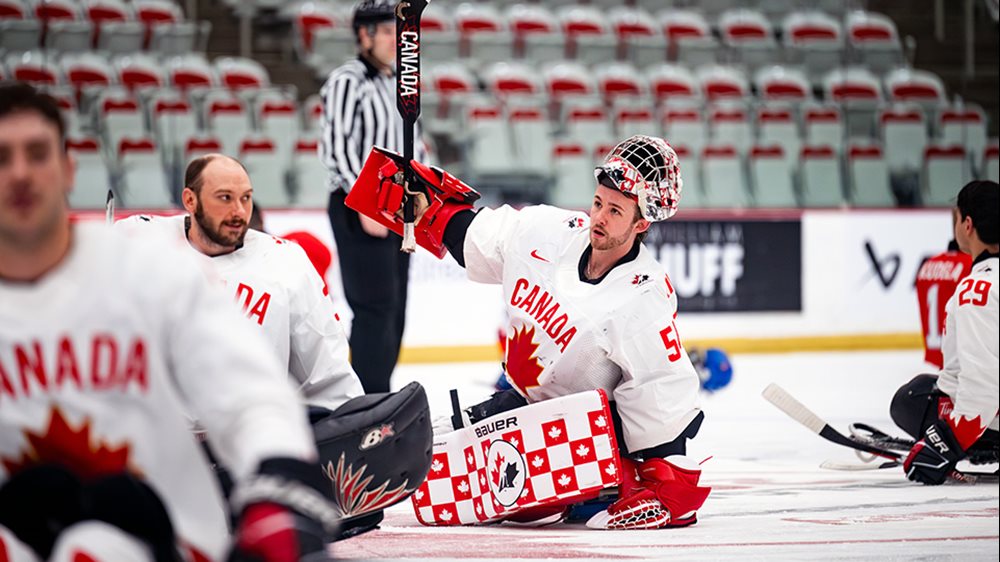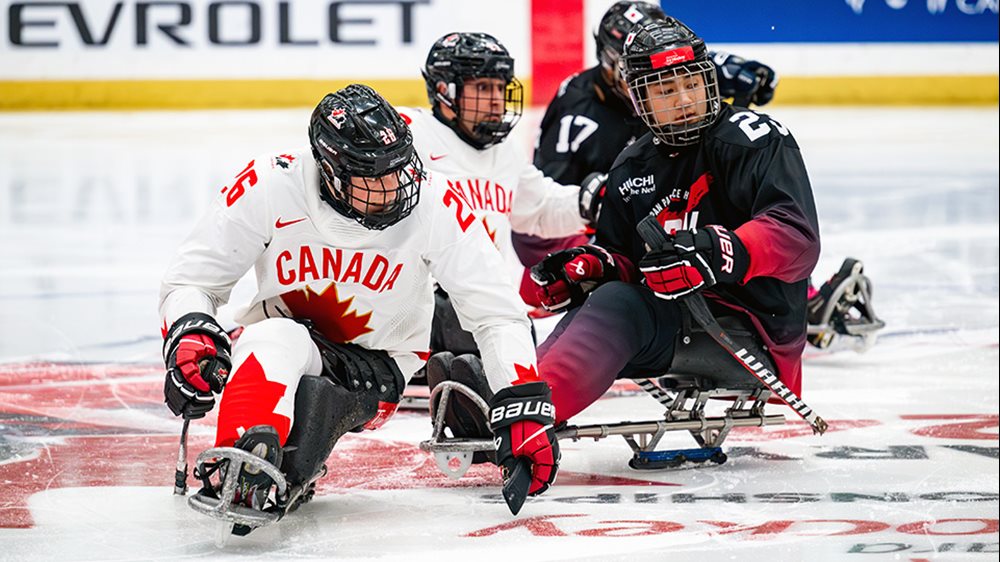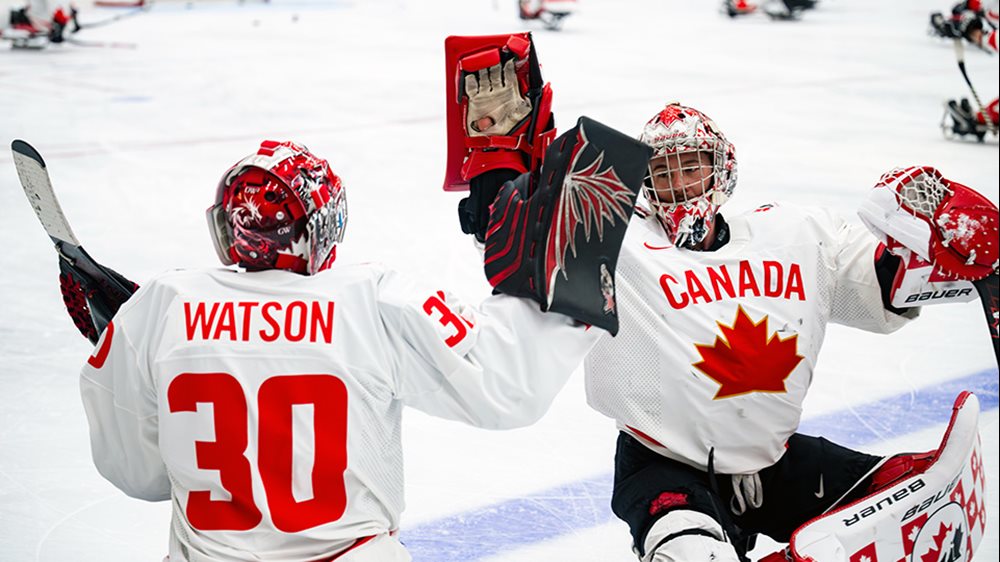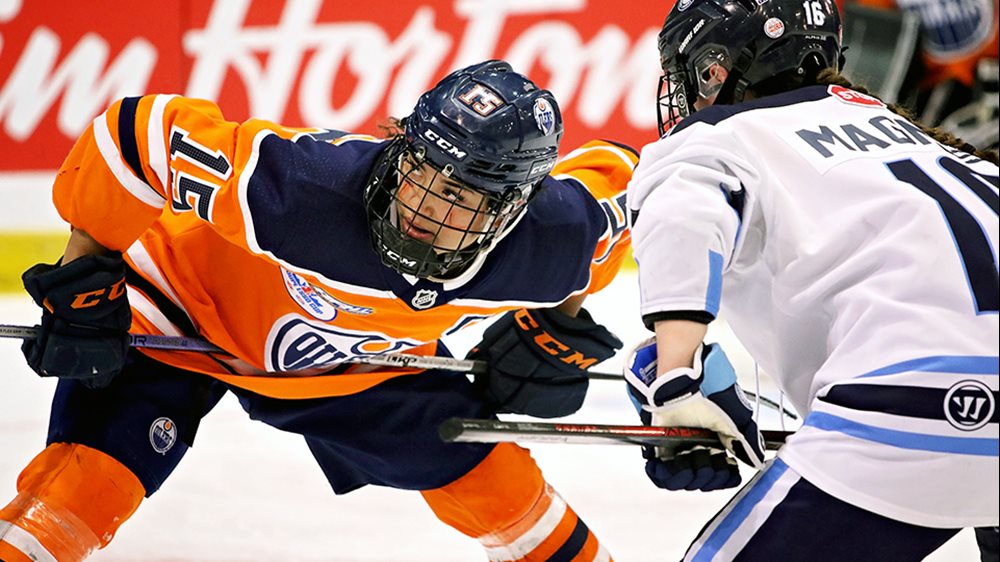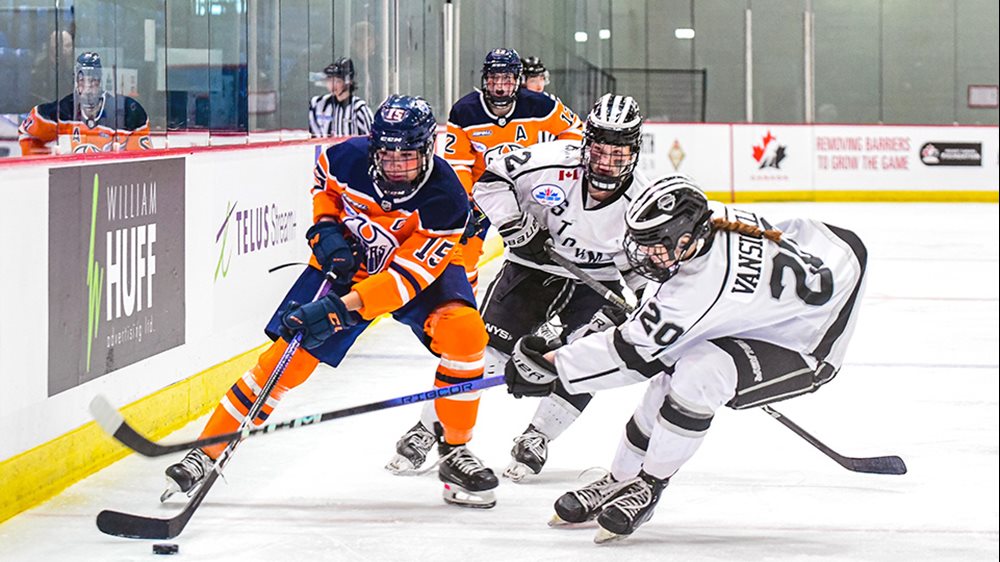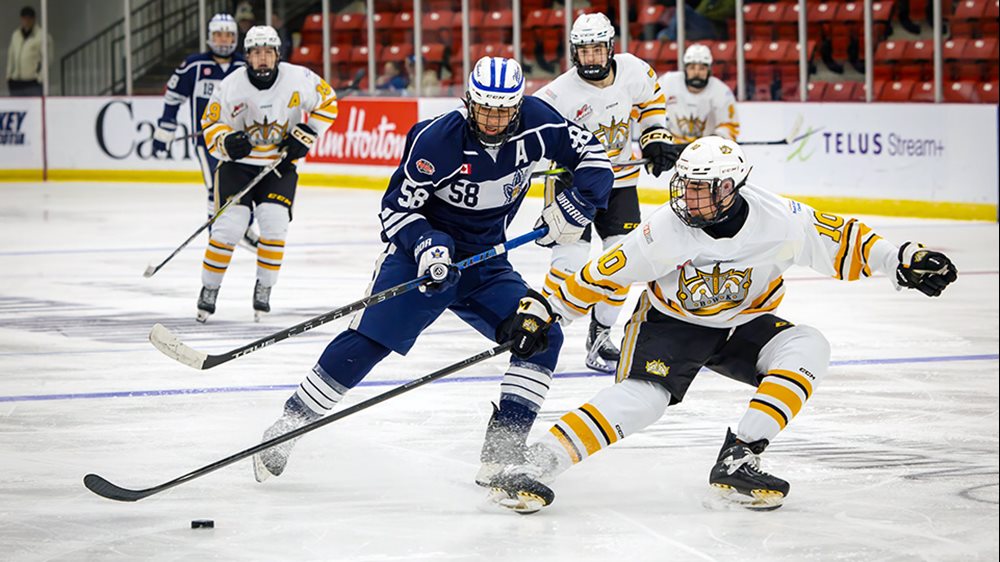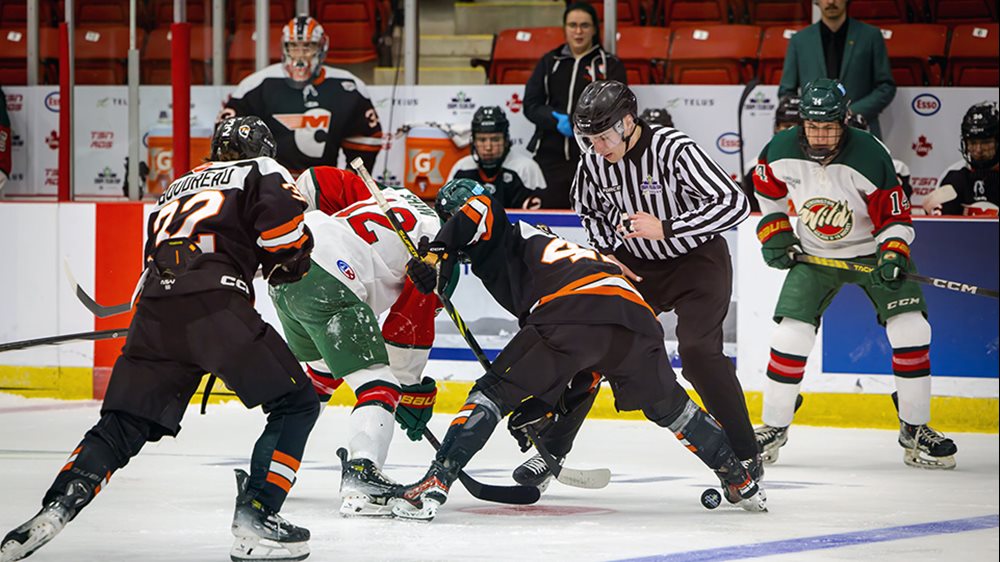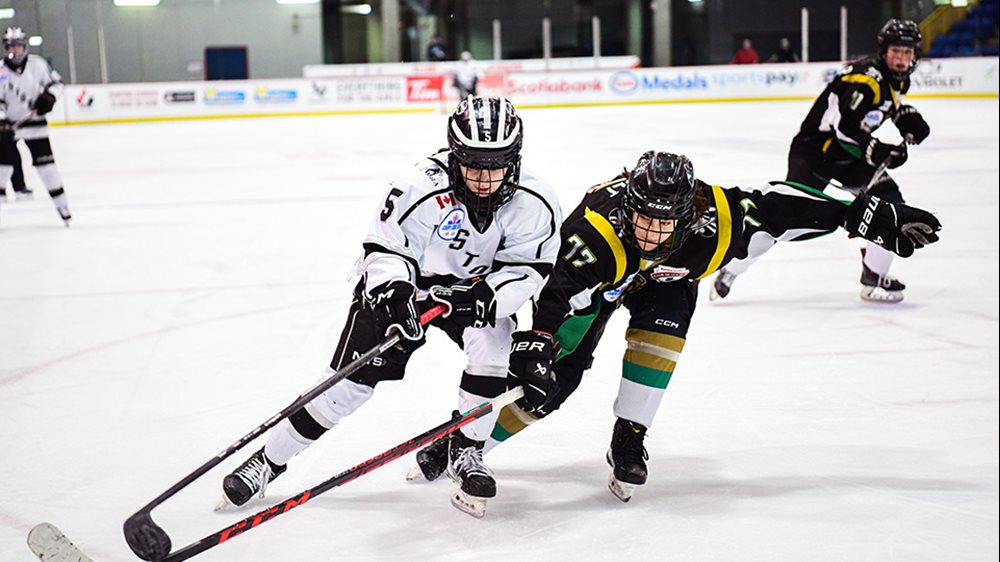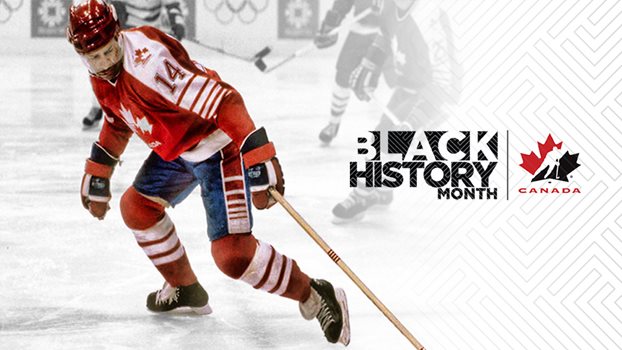
In My Own Words: Darren Lowe
The first Black player to represent Canada at the Olympics looks back on his journey in the game, from neighbourhood rinks to Sarajevo and the University of Toronto
I’ll start by saying this – I don’t consider myself a trailblazer.
I get asked about certain things I accomplished … about being the first Black coach in Canadian university hockey, about being the first Black player to play for the Pittsburgh Penguins, about being the first Black player to represent Canada at the Olympics.
I guess I don’t really think about these as ‘firsts’. They were just part of my hockey journey, regardless of the colour of my skin. People ask me about being a Black player, but I only thought of myself as a hockey player.
I'm nowhere near the type of player Jarome Iginla is and was, or P.K. Subban. They weren’t Olympians because of me; they were Olympians because of the talent they had. It wasn’t because they were Black; it was because they were great players.
But to be mentioned in the same conversation as them? That’s something pretty special.
This is a pretty Canadian thing to say, but I was a hockey-obsessed kid. Because my dad was involved in hockey, it was just natural that my brother and I played. We were lucky enough to live on a street in Toronto that had city rinks at both ends, so we had access to ice all the time. And when it wasn’t cold enough, we played ball hockey day and night. We lived and breathed the game.
I got into organized hockey on those same rinks, playing outdoors. I played in the Catholic Youth Organization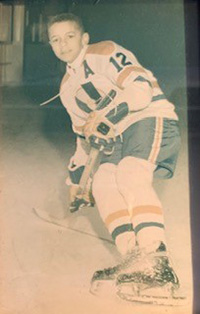 (which was strange, because I’m Protestant) in my early years and won a provincial championship. I moved on to the Metro Toronto Hockey League (today it’s the GTHL) and played there through Midget.
(which was strange, because I’m Protestant) in my early years and won a provincial championship. I moved on to the Metro Toronto Hockey League (today it’s the GTHL) and played there through Midget.
Being from Toronto, such a multicultural city, I was rarely the only player on my team who was Black, or at least from a different cultural background. I can’t say there was never name-calling or racial comments, but they were few and far between. I've heard stories from other guys about how terrible the racism was, and not even wanting to go to the rink. I never really experienced that. Was there something underlying that I wasn't exposed to but people were talking behind my back? Maybe. But to my face? Not so much.
Once I got to junior, a couple of times there was some name calling, which ended up – I'm not proud to say this – in a fight after it happened. But it wasn't something that deterred me from going to the rink or made me really uncomfortable, and we had family discussions about it all the time.
Family has always been so important to me. By the time I started playing hockey and my brother started playing hockey, my dad was kind of out of the game. So we only heard the stories of his days on the ice. And they were so much fun to hear.
In the early 1950s, my dad ended up in Mount Forest, Ont., about two hours northwest of Toronto. He travelled with another guy for a potential job, and after he got on the ice and they saw how he played, they wouldn’t let him leave. Apparently, they hid his clothes so he had to stay.
Dad ended up playing Intermediate hockey with the Mount Forest Redmen on an all-Black line with Howard Sheffield and Gary Smith , which was pretty rare back then. But it’s a great piece of history and something our family is so proud of.
My dad coached my brother and I a little bit when we were young, but not for long. He wasn’t an overbearing hockey parent that yelled at the rink or anything like that. He was pretty quiet, but one-on-one, his thing about hockey was scoring. It drove me to want to score all the time, and if you look at my career numbers, I think I did okay!
After my junior days, I ended up with a full scholarship from U.S. International University, which was based in San Diego and was going to play NCAA Division I hockey. I headed south, not really knowing what to expect. I spent a year down there and we played some great college teams. That’s where I took off as a player. My stats were really good against great competition and academically I did really well. Because of that, it allowed me to get into the University of Toronto.
I loved playing at home. It was the right level for me, and the confidence I got from those years led me to Sarajevo in 1984.
The journey to become an Olympian was an interesting one. From my performance with the U of T, I had earned a scholarship from Hockey Canada … I think there were only 50 or so handed out across the country. As a recipient I ended up on the radar of the national team and was invited to Calgary to be part of the team during the 1983-84 season leading up to the GamesI went through the process but didn’t think I had any real chance. Up against guys who were drafted into the NHL, the odds were just not in my favour. I was on the bubble and always having to prove myself.
That season was an absolute grind. We were based in Calgary, but I think we only played eight games there all season. We played series against the United States, we played against the Russians, we went to a bunch of tournaments in Europe, and I think it was maybe 80-something games. I'd wake up in a hotel room and I wouldn't know where the heck I was because we travelled so much.
When we got back from a tournament in Sweden, a few guys, myself included, were given the option of returning to school. We weren’t being cut, but we were told there was no guarantee we’d make the team.
But this was the Olympics. When would this opportunity come around again? Probably never. So I was committed. The odds were against me – they were bringing guys in and out all the time from different places – but I still had a lot of confidence. Even at the last minute, I think they had thoughts about maybe not keeping me, but I ended up on the top line in the Olympics. So things just worked out.
The experience in Sarajevo was great. Living in the Olympic Village was different – there were armed guards everywhere and you had to check in and out all the time – but it was a lot of fun. There was an entertainment centre and we used to go play pinball, because that was a big thing back then. The day of the game, we'd go play pinball.
On the ice, we played great. We won our first four games to clinch a spot in the medal round. In the end, we had a game for the bronze against Sweden and we just couldn’t get it going. We lost 2-0. Would I love to have an Olympic medal right now? Of course. But just the fact that I was at the Olympics was an amazing experience. And we got to go to the other events and meet the other athletes. It was like a Canadian community – we went and watched figure skating when we could, we went to bobsleigh, we went to speed skating. Gaétan Boucher was in the Olympics that year in speedskating, and it was outdoors. There are a lot of great memories like that.
One amazing hockey memory led straight to another. Coming out of the Olympics, I had a couple NHL offers. I didn’t even have an agent, but Doug Lidster, who had been a roommate of mine through the season, set me up with his. I ended up in Pittsburgh and played my only eight NHL games with the Penguins. The running joke is that they were going hard after Mario Lemieux and wanted to finish with the worst record so that’s why they signed me. Did I ever realistically think I'd play in the NHL? Probably not. I was an average player as a kid. I just worked at it.
Because I played those eight NHL games, I lost a year of university eligibility. So for the 1984-85 season, I bounced around a little. I went to training camp with Edmonton, I played a couple exhibition games for Team Canada, helped it win the Spengler Cup the first time it went to Davos for the tournament and played a little bit of Senior hockey before I headed back to school in the fall of 1985.
I was finishing up teacher’s college, but halfway through the year I signed a contract to play pro in Europe starting in the 1986-87 season. It was challenging for me to complete my education, but I knew I had to do it because I didn’t know if I was going to ever make a lot of money playing hockey and I had to have something to fall back on.
I had a great time in Europe, living and playing in Vienna and Helsinki, learning more about the game and about myself. I came back for 1987-88 and had an unbelievable year in the IHL with Flint, finishing third in the league in scoring with 117 points. That took me to Maine in the AHL for a season and back to Flint before my playing career finished up in San Diego in 1990-91.
I got right into teaching when I retired, but I knew I wanted to coach. I called up Paul Titanic at the University of Toronto, but his staff was full. I ended up as an assistant at Ryerson, where we didn’t win a game all season. It wasn’t pretty, but I learned a lot. I got on at the U of T the following season, we won the OUA title and reached the national final, and I was off and running from there.
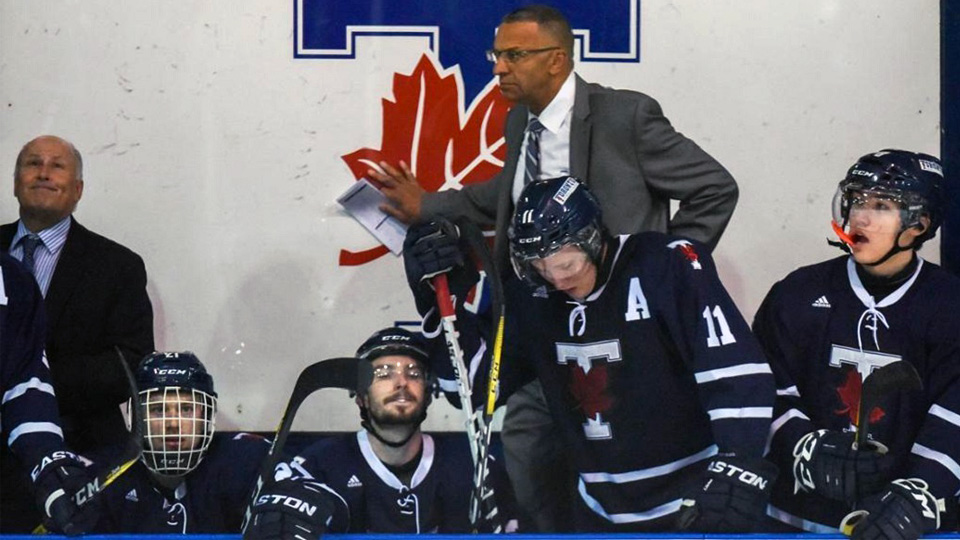
Two years later I became the head coach when Paul stepped down. It was another hockey dream come true. As a kid, I went to games at the U of T. I played my university hockey there. The rink was always packed, and to think that I was going to become the head coach was amazing.
I had no coaching experience other than an assistant coach. I fell back on some of the things I learned from the coaches that I had, and I had some great coaches when I played. And I made a million mistakes. I was probably a terrible coach at times, and sometimes I was good. We had good teams, we had bad teams.
I love the university game. The players are student-athletes in the purest form. They know they aren't going to become pros, but they want to play hockey at the highest level they can. If you can have an impact on their lives in some small way, it’s all worth it.
I stepped away from coaching in 2017 because it was time. I had the opportunity to change my life, to spend time with my family because my kids were still young enough that they were at home, and I could go to my son's hockey games, and I could go to my daughter's soccer and volleyball games. I could be a real dad and a husband, and eat dinner at home with everybody.
Today I’m an instructor at the U of T, teaching a coaching course and something called Pedagogy of Playing Games. I don't like marking, but I love teaching and I love working with the students.
So that’s me. I had a lot of fun when I played, and I made the best of my limited abilities. I worked my ass off. And that's what people do when they have a passion.
Hockey was never a job, and I am forever indebted to the game for what it has given me.
About the author Darren Lowe represented Canada at the 1984 Olympic Winter Games, recording two goals and an assist in seven games as Canada finished fourth. He also helped Canada win the 1984 Spengler Cup. The Toronto native played 336 games of professional hockey, including eight NHL games with the Pittsburgh Penguins in 1983-84, before spending 25 seasons on the staff of the men’s hockey team at the University of Toronto, including 22 years (1995-2017) as head coach.
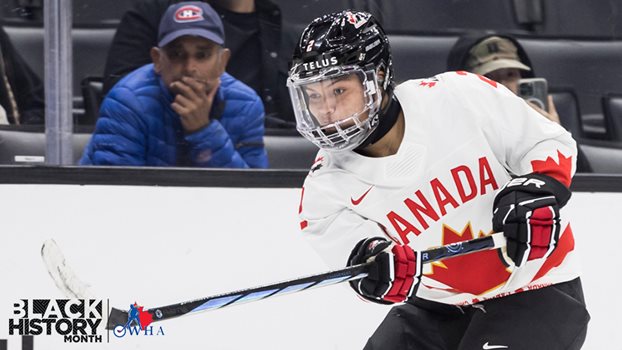
Jaques ready for what comes next
After a decorated academic and athletic career at Ohio State University, Sophie Jaques is using her place in the game – with Team Canada and in the PWHL – to inspire the next generation
Sophie Jaques had plans to pursue a career in civil engineering.
Instead, the 23-year-old finds herself living out her dream as a professional hockey player with PWHL Minnesota.
“It’s been a really exciting time for women’s hockey,” Jaques says. “It’s been great to play alongside the best players in the world and learn from all their experiences.”
Jaques was born in Toronto and grew up in the city's west end, where she developed an early love for hockey.
“I started playing hockey at Rennie Park by my house,” she recalls. “I really liked it, so my parents put me in a learn-to-play program and I fell in love with the game from there.
“I remember always having a smile on my face and enjoying the time with my friends, enjoying hot chocolate and those little things like jumping into the snowbank after the Zamboni came off the ice.”
While attending Silverthorn Collegiate in Etobicoke, Jaques played three seasons with the Toronto Aeros of the Provincial Women's Hockey League — now called the Ontario Women's Hockey League — winning league championships in 2016 and 2018.
Jaques recalls spending countless hours working on her game throughout her early years.
“I went to a lot of shooting clinics when I was younger, working on my shot in the backyard, and I think that helped take my shot to the next level and [it is] something I continue to use every time I step on the ice now.”
That level of commitment is what helped set Jaques apart, whether it was hockey or academics — something that became extremely evident in her five seasons at Ohio State University.
[Photo or social media post goes here]
Making history at OSU
Jaques’ teammates and coaches in Columbus describe her as an easygoing and brilliant student-athlete, but it was on the ice where her character and strength shone through with the Buckeyes.
“Things come naturally for Sophie,” says Nadine Muzerall, women’s hockey head coach at Ohio State. “Seeing her maturity grow over the years, her confidence was a big piece of that growth, and finding success on the ice, she became a leader.”
As a rookie in 2018-19, she led all OSU rookies with 21 points (6-15—21) before topping that with 24 points (9-15—24) as a sophomore.
After posting just two goals and four points in 20 games during the COVID-affected 2020-21 season, Jaques exploded as a senior. her 59 points (21-38—59) in 38 games rank as the second-most by a defender in Western Collegiate Hockey Association (WCHA) history and the most in Ohio State history. Her contributions led the Buckeyes to their first NCAA national championship and put the women’s hockey world on notice.
“It finally all just clicked that season,” says Jaques. “I developed more confidence in myself, and it allowed me to play at my best. The next season, I wanted to prove that it wasn’t a one-off season, that it wasn’t a fluke that senior season, and that I could play that way."
Jaques returned for a fifth year and picked up right where she left off. Not only did she earn a fellowship from OSU to fund her final year to complete her master’s degree in civil engineering, Jaques put up another 48 points (24-24—48) in 41 games, becoming the first Black woman and only the 10th Canadian to be awarded the Patty Kazmaier Memorial Award as the best women’s hockey player in the NCAA.
“She’s one of the best defencemen to play college hockey and the fact that she joined before OSU was number one in the country, and she helped build this program, that says a lot about her character and being a builder,” Muzerall says.
Jaques filled her trophy case at Ohio State; in addition to the Kazmaier Award, she was a two-time First Team All-American, two-time WCHA Defender of the Year, WCHA Player of the Year, WCHA Outstanding Student-Athlete and a four-time member of the WCHA All-Academic Team.
In 2022, she won the Arthur Ashe Jr. Female Sport Scholar of the Year, an honour presented to a minority woman who has distinguished herself in her academic and athletic pursuits..
“I’ve coached a lot of people who had success, but I’ve very rarely coached someone as successful as Sophie,” says Muzerall. “In terms of point production as a defenceman, she’s the only person from Ohio State and all its respected programs to win the Arthur Ashe award, and she humbly accepted it. She was receiving national recognition, not just as a hockey player, but as a brilliant student-athlete, and that has never been done before.”
2022 NCAA National Champion. The first Buckeye Kazmaier winner. The first Black Kazmaier winner. Sophie Jaques is a first-mover, who never stands still which is why she is tonight’s Match Ignitor.#Crew96 ✘ @OhioStateWHKY pic.twitter.com/nUBOhmbfff
— The Crew (@ColumbusCrew) April 30, 2023
Reaching out to the community
Jaques’ achievements on and off the ice as a student-athlete only grew the game as her influence and leadership were felt among the young girls and boys in the community.
After finishing her college career last spring, Jaques returned home to Toronto to team up with Saroya Tinker to host the first Black Girl Hockey Club Canada summer camp, sharing her knowledge and experience with the next generation in the community she grew up in.
“At the beginning, it was something that I didn’t really know was happening, but I’m grateful to be in the position where I can inspire others,” Jaques says. “I want to help get more girls into hockey, and hopefully break down more barriers surrounding the game. It’s incredible to know now that I can play a small part in continuing to grow the game.”
Her reach only grew last November when she made her debut for Canada’s National Women’s Team in Los Angeles during the Rivalry Series. “It was an incredibly grateful feeling to represent my country,” Jaques says. “Playing alongside someone like Jocelyn Larocque, who I watched when I was a young girl, and being around all those girls who have been pioneers for the women’s game, to finally get the chance to wear that jersey with that group, was incredible.”
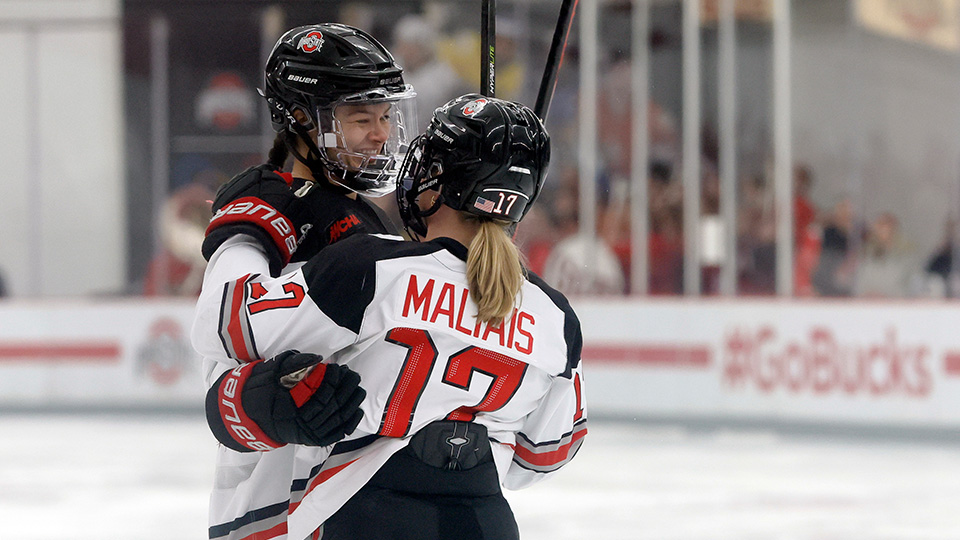 Emma Maltais, who played with Jaques at Ohio State, was more than happy to
welcome her friend to the national team. Before the game, it was Maltais who
handed Jaques her Team Canada jersey.
“Sophie’s been dreaming of that moment for a long time,” says Maltais.
“She’s so humble and for someone who is so good, there’s a calmness to her
while she plays at such a high level. She’s so driven as a person too, in
athletics and academics, and that speaks a lot to her as a person and her
willingness to go the extra mile to find success.”
Emma Maltais, who played with Jaques at Ohio State, was more than happy to
welcome her friend to the national team. Before the game, it was Maltais who
handed Jaques her Team Canada jersey.
“Sophie’s been dreaming of that moment for a long time,” says Maltais.
“She’s so humble and for someone who is so good, there’s a calmness to her
while she plays at such a high level. She’s so driven as a person too, in
athletics and academics, and that speaks a lot to her as a person and her
willingness to go the extra mile to find success.”
Trailblazer once again
After her outstanding college career, Jaques made history by becoming the first-ever Black player and the first Buckeye to be drafted into the PWHL when she was taken 10th overall by Boston — something that wasn’t even an option for her a year ago.
She made history once again earlier this month by being part of the very first PWHL trade when she was dealt to Minnesota.
“I'm really grateful that this year, it is a sustainable league with liveable wages so that I could pursue hockey,” she says. "With the PWHL being here, it helps with the next generation of Black hockey players see representation and show them that it is possible and keep them motivated in their journeys."
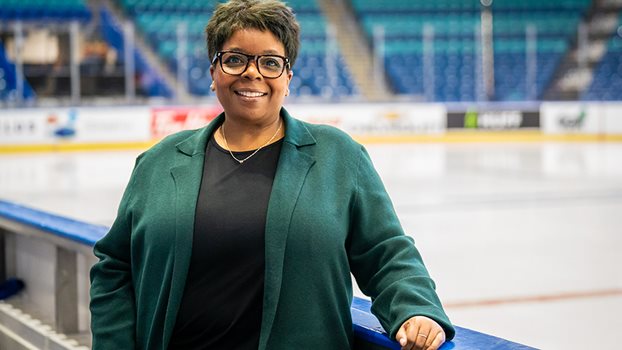
Questions & Answers with Esther Madziya
The Hockey Canada communications manager opens up about her career path, working in sports media as a minority woman and what she’s telling the next generation
If you’re a working media member that has covered Canada’s National Women’s Team over the last four years, you know the name Esther Madziya.
But if you’re not and you don’t, you should.
A Hockey Canada communications manager, Madziya was part of the staff with the Olympic gold medal-winning team at Beijing 2022, sandwiched around a pair of IIHF Women’s World Championship gold medals, spending weeks and months on end in bubbles and quarantines during the COVID-19 pandemic, away from family and friends, with that singular golden goal in mind.
Outside of her Team Canada work, Madziya is an integral part of the Hockey Canada family, and was recognized for her contributions with the Hal Lewis Award as the organization's staff person of the year for the 2018-19 season.
To celebrate National Women and Girls in Sports Day and Black History Month, HockeyCanada.ca sat down with Madziya to talk about her journey and how the industry has evolved for minority women.
HC: How did you get your start in sports media?
EM: I went to SAIT [the Southern Alberta Institute of Technology in Calgary] and took the broadcast journalism program. The program has evolved since then, but it was called CTSR – Cinema, Stage, Television and Radio. And then you could specialize in whatever you wanted to do.
I wasn't sure what I wanted to do at school. Way back when, I wanted to get into accounting, which is not my jam at all, but I always liked sports. And I thought, ‘You know what, maybe I want to get into sports.’ So I took the broadcast program at SAIT, with the hope of getting into sports broadcasting and one day maybe being on TSN.
I ended up getting a job in radio. I did a practicum in Lethbridge, which is my hometown, at the radio station. The station also had the broadcast rights to Lethbridge Hurricanes games, so I was covering the intermission reports and updating scores and stats, and it just evolved from there.
HC: What was the landscape like in sports media for women when you came out of university?
EM: At that the time, there weren't a lot of women in sports. There was also not a lot of diversity, in broadcasting and in sports in particular.
Growing up, my parents always said, ‘No matter what happens, you are going to have to work harder than the next person. You're going to have to prove yourself all the time, because you are a woman and because you are a minority. Nothing's going to come easy for you.’
So that was just something that always stuck with me. And I remember some of my colleagues at SAIT, as we got closer to graduation, saying that it would be easier for me to get a job because I was a woman and a minority, which I didn’t necessarily agree with. But if being a woman and being a minority was going to get my foot in the door, then you know what, I'll accept it. But at the same time, if I can't do my job, it's not going to keep the door open very long.
It was just the reality of, you're going to have to work twice as hard as the next person if you want to have any opportunities. That was just something that always stuck with me.
HC: You’re coming up on nine years with Hockey Canada later this week; what was the career path to get here?
EM: I worked at the radio station in Lethbridge for four years, working the morning show and doing intermission reports with the Hurricanes. I moved into television at Global Lethbridge for a few years, and in 2002 was lucky enough to get a position as a sports reporter at Global Saskatoon. I focused on a lot of university sports, did men's and women's hockey, reporting on those. That was my beat. Canadian Junior Football, I covered the Saskatoon Hilltops. I covered volleyball, curling – learned a lot about curling – covered a lot of SJHL hockey, minor hockey, all that kind of stuff.
In 2010 there were cutbacks, and the industry as a whole was changing, so I decided to go home to Lethbridge. I went back to the radio station, started doing the morning show again, which I never thought I’d do, and was involved with Hurricanes games on both TV and radio.
A year later, the Hurricanes’ communications manager took another job in the Western Hockey League, and the team offered me the position. I was with the team for four years before the Hockey Canada position came open, and I started in February 2015.
HC: You’ve had the opportunity to work with amazing athletes, travel to amazing places, have a front-row seat to Canadian hockey history. What is that like?
EM: Honestly, it's hard to describe, because unless you're in it, you can't even really describe it. But never in my wildest dreams would have imagined that I'd have the opportunities that have come my way. I never would have imagined that I would have gone to some of the places that I've gone, had the opportunity to work with some of the athletes that I've worked with, had the opportunity to cover events, whether it’s from the event side or being embedded with a team.
I think the other piece that makes it special is what it means to my family. My family is incredibly proud of just seeing that this kid who, when she was younger, probably didn't always have the greatest focus on her studies, is doing what she's doing now.
There are times when I’ve hosted a press conference, and my family tells their friends, ‘That's our kid. That's my sister. That's my daughter.’ They're so proud of that, and that means the world to me, but I also know that I've always tried to be really respectful and try to work hard, and do right by the Madziya name. It means a lot to them, just as much as it means to me.
HC: You’ve mentioned your family a few times, and the influence they’ve had on you. How important has that support system been as you’ve progressed through your career?
EM: No matter what I wanted to do with my life, they've always just been in my corner. And I think for any kid to have their parents say, ‘We're so proud of you, no matter what you do. We see the work that you do,’ it's a cool thing.
Our last name is Madziya. We're the only Madziya family here in Canada, and they're really proud of that. Their support just means a lot, because they've always been there. My mom always says, ‘Look at the opportunities that you've been given, look at the jobs that you've had, and appreciate that. And even though there might be some hard times along the way, those hard times strengthen you and they're the reason that you keep having the opportunities that come your way.’
HC: To be one of the faces of Team Canada with national and international media… does that carry a little more weight, mean a little more, because you’re a minority woman?
EM: Absolutely, because there still is a little bit of, ‘Do I really belong here?’ In the back of my mind, there is still that little bit of… watch how you walk, watch how you carry yourself, watch how you're dealing with somebody, watch how you're dealing with other media, because if you offend somebody, it’s pretty easy to say, ‘Well, it was her.’
In the back of my mind, I'm always still thinking about working twice as hard. I just don't want to make any missteps, because I feel like somebody is just waiting for me to make a mistake to say, ‘See, that person can't do it. She's not qualified. She was just a token hire.’
Those things still play in the back of my mind. I don't think those things will ever not play in the back of my mind.
HC: Women’s hockey has grown by leaps and bounds in recent years, and you’ve been able to see it up close. What has that been like to watch the game evolve?
EM: It’s pretty cool to see, because there's a lot of hard work that's gone into growing the game, and you see how passionate the athletes are, but you also see how passionate the staff is. So seeing where it's at and seeing so many people work so hard, that brings me a lot of joy, because they had their dreams when they were a little girl. And to see where things are at and to see the things that they've been able to do and accomplish, but to also get a front row seat to it, is pretty cool.
And I think one of the neatest things for me is that because I've been here nine years and have worked up and down the National Women’s Program, and at national events like the National Women’s Under-18 Championship, I’ve been able to see players from 16, 17, 18 years old through to the national team, and see the difference they’re making now. It’s pretty cool to see that progression – as hockey players and as women.
HC: Throughout your career in the media industry, how have you seen the doors open for women, and for minorities?
EM: It's like night and day. The industry has changed for the better. There are more opportunities, more doors opening up today. I think a lot of organizations have looked at their product and asked, ‘Is our TV program, is our news program, is our sports program indicative of what the rest of Canada looks like?’ Because it has to, otherwise you're not going to connect with people and you're going to lose them.
There are so many different avenues today. There are podcasts and influencers and so many other things that people are doing on their own. You're seeing a lot more women in different roles. And we're seeing a lot more of that because it's about hiring the best person that's out there.
HC: What advice do you have for women, or minorities, that want to get into sports but maybe don't feel like they have a path?
EM: If that's what you want to do, pursue it. Don't let anybody stop you. Somebody may say no, a door may close, but it's not no forever, and there's going to be another opportunity. Obviously if somebody says no, it cuts deep, but it just means not right now. Know that you belong there just as much as the next person. At the end of the day, everybody puts their pants on the same way.
So, pursue what you want to do. Don't take no for an answer, do your research, be confident and go in knowing that you know that you can do the job. Treat people with respect, and you'll hopefully get that respect back. Nobody should ever tell you that you don't belong.
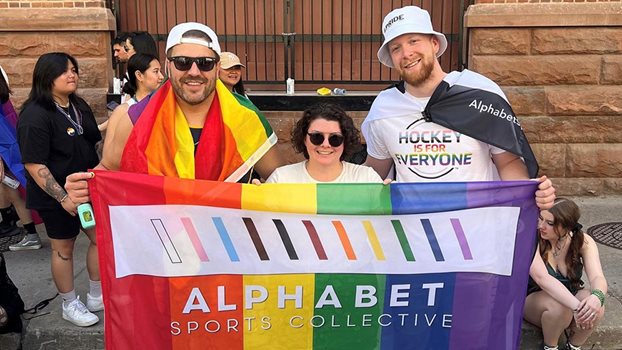
In my own words: Bayne Pettinger
The NHL agent talks about coming out, his work with Hockey Canada and making the game safer and more inclusive for the queer community
COVID-19 changed my life … in the best way possible. Strange, I know.
I was out to my family and close friends for a couple of years before the pandemic hit. But I lived in this world where I was running around, pushing deep thoughts to the back of my mind, saying, “I’ll deal with that later.” It was a fear of combining my personal life and my professional life.
But when COVID hit, I got to go home to Victoria. The world stopped, and so did my life as I knew it. The phone wasn’t ringing and the emails weren’t coming. The things that kept me occupied. It gave me the chance to sit down and have honest conversations.
I remember talking to Tyson Barrie, who was a client of mine and a good friend going back to our days growing up on Vancouver Island, and saying, “Hey, you know what? I think I’m going to come out.”
I thought maybe I’d just do an Instagram post, something simple. But Tyson and some other important people in my life thought I could really do something impactful, that I could be a face for the queer community in the game, because it was something hockey desperately needed.
So that started my journey. I began coming out to others, to big names in the game who I had crossed paths with through the years. When I told Connor McDavid, his response was simply, “Okay, that doesn’t matter.” I got a text from Sidney Crosby, who congratulated me and let me know he was there if I ever needed anything.
On Nov. 5, 2020, with the help of an article in The Athletic by Pierre Lebrun, I came out publicly.
Without discrediting how important my coming out was for my mental health, nobody really cared. It didn’t change how the hockey community saw me. Instead, it was … “Hey, you’re Bayne. You don’t judge us on who we date or who we’re attracted to. So why would we judge you?”

I got my foot in the door with Hockey Canada as an intern in the finance department in 2009 (I’m not much of a numbers guy, but it was the only position available at the time). From there I joined the hockey operations department in 2011, and my first assignment was the 2012 World Juniors in Alberta. I was travelling the world with Team Canada, riding these highs of winning gold at the Olympics, the IIHF World Championship and the World Juniors. And I was hanging around with a who’s-who of hockey, whether it’s Doug Armstrong, Jon Cooper, McDavid or Crosby. I left Hockey Canada in 2019 to become a certified NHLPA agent with CAA (Creative Artist Agency) and relocated to Toronto, finding my niche in the game and my personal happiness.
But there was always this fear that I couldn’t live my true life – to be accepted as a gay man – and also be a successful young executive in the game. It was a conundrum that kept me in the closet for a long time.
And it was that fear I needed to break down. It’s human nature – you always think the craziest things are going to happen, right? You’re going to tell someone and they’re going to not be your friend anymore. You get these thoughts in your head that you won’t be accepted or pushed out of hockey for some reason.
But that’s not what happened.
When I look back, I wonder why I was so anxious. And that’s what I try to preach to people who have reached out that are still in the closet thinking they won’t be accepted. The amount of outreach I had from people around the world, in the hockey world specifically, saying, “Hey, great for you. That’s awesome. You’re going to do great things,” was amazing. Just the overall support from friends, family, and even strangers was surreal to say the least.
And by no means did I ever think I’d become a face of being a queer man in hockey. But once I crossed that threshold and people reached out, I’m happy to speak on it. I think it’s important because you have to be out there and not everyone has the voice or platform to speak up.
That’s one of the reasons I helped launch the Alphabet Sports Collective (ASC) in March. We are a queer-led, not-for-profit that is empowering queer youth. Working with my co-chair, Brock McGillis, and ambassadors like Gord Miller, Jon Cooper, Morgan Rielly, Tessa Bonhomme – the support has been absolutely amazing.
We want to get our community to feel good about themselves. So if they want to work at Hockey Canada, or they want to be a sports agent, or they want to play in the NHL, now they have those faces, those supporters. Because I’m a strong believer that if you’ve never seen something done in front of you, you can’t tie to that and see yourself in those positions.
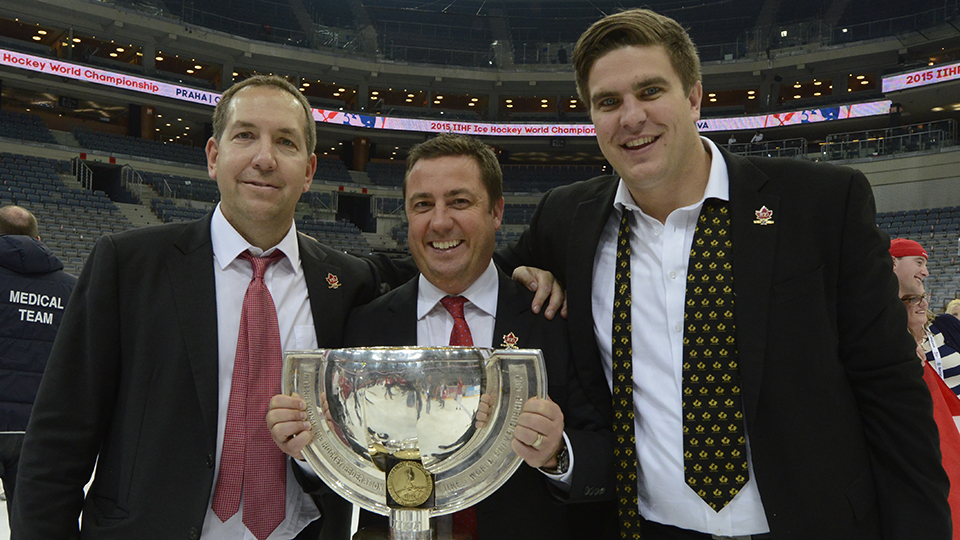
I’ve kind of come full circle now and I’m working with Hockey Canada as part of their ED&I (equity, diversity and inclusion) Task Team. I’ve really enjoyed it. I think it’s important to have representation from all walks of hockey.
For me, the key is showing vulnerability. Hockey Canada needs to get out there and listen to the issues and not think it has all the answers. We can write all the policies we want, run all the seminars we want. But we have to get to the grassroots of it. We need to hear the voices of the community, and there are groups out there that have done the work and understand the issues at hand. We don’t need to reinvent the wheel – we need to listen and learn.
I’m really proud Hockey Canada has this new group and it is listening and taking notes and not just rushing out a statement. Anyone can put out a statement. Let’s actually learn and implement new procedures and training so we’re not just spinning the wheel and checking the box. That’s the goal.
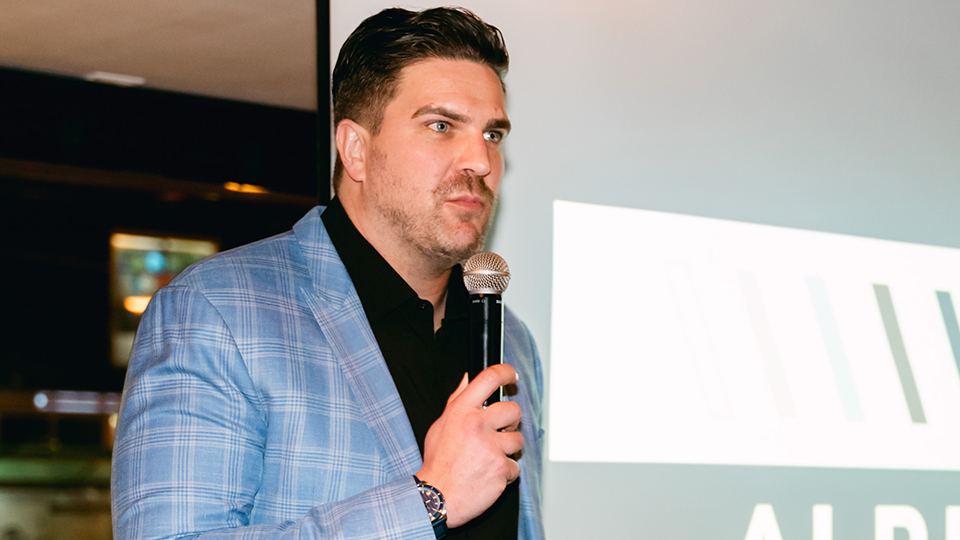
So now for the million-dollar question – where do we go from here?
I think it’s representation. To get the queer community empowered and feeling good about themselves, and then get a member of the community on the Hockey Canada board, get members of the queer community on NHL boards, get them on minor hockey boards, get them coaching, get them as trainers. To get that representation at the governance level, to have that voice and have that perspective, that’s the ultimate goal. Every community needs to be represented. People of colour, people of different religious backgrounds, people of the queer community. Because that’s what makes up Canada. So, if we’re really going to have a board that represents our country, then we need to have a queer seat there.
I want to get it out there and have open conversations and try and educate and humanize, but we’re not going to change everyone’s minds, and that’s not what we’re trying to do. We’re trying to say that the rights that you have, the equality, the celebrations, we want that for queer people.
I think sports are behind the rest of society. If I worked at a bank, I wouldn’t even really have to come out. It’s a big deal in hockey because there has never been anyone that’s done it, and it’s a hypermasculine sport, and we don’t talk about our feelings. We just play hockey and it’s the crest on the front, not the name on the back. Don’t bring your personal problems here – that’s how I was raised in the world of team sports.
But I think with some of the things we’ve seen in the news recently surrounding Pride nights, we’ve actually broken that down a bit and had honest conversations and opened people’s eyes that this is still an issue, that there are still some bigoted views and that it’s not a safe place for everyone yet.
The latest from last week, that NHL teams will no longer wear pregame jerseys for any causes, is disappointing to say the least. Nobody seems to want to focus on the 700+ players who supported our cause and wore Pride jerseys last season, it’s all about the miniscule group that refused. Pride nights (not to mention Hockey Fights Cancer, military appreciation and Indigenous celebrations) were successes across the league, and it’s sad to see the decision that was made.
With all that said, I truly think change is coming, and it starts with our youth.
I coach a U14 minor hockey team in Toronto. When I came out to them, their response was, “Whatever.” It didn’t change anything with them. When I came out to some of my young clients, it was, “It makes you happy and we’re happy for you.”
They’re understanding, they’re compassionate and they really don’t care, but in a good way. A lot of people seem to have a poor opinion of millennials – that they play too many video games and they’re lazy and the old “back in my day, I didn’t do that” mantra. But we’re at a point where the next generation is so eyes-wide-open and accepting that I find the future really promising, and I really think we’re in good hands on diversity and inclusion with our youth coming up.
To finish, I want those that are struggling to know that they’re not alone. There are resources, and there are people to talk to to help you feel accepted. It’s human nature to focus on the negatives, but there are a lot of us trying to break down barriers so queer people feel comfortable working or playing sports and living as their authentic self.
I would never want to be pushed away from the game I love because of sexual orientation. And I thought that was the case for a while, but it’s been the exact opposite.
Who knew? The big, bad hockey world isn’t that big and bad after all.
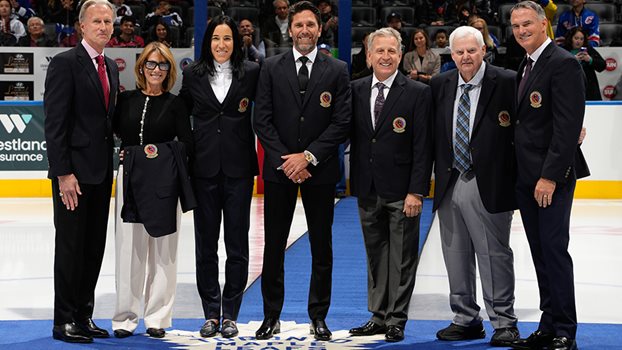
Fab five headed to the Hall
Hitchcock, Lacroix, Ouellette, Turgeon and Vernon part of Class of 2023 for Hockey Hall of Fame
There will be a distinctly Canadian flavour when the Class of 2023 goes into the Hockey Hall of Fame this fall.
Of the seven names announced Wednesday, five have a Canadian connection – Caroline Ouellette, Pierre Turgeon and Mike Vernon will be enshrined in the player category, while Ken Hitchcock and Pierre Lacroix will go in as builders.
A closer look at the inductees…
Caroline Ouellette is one of the most decorated players in international women’s hockey history, winning four Olympic gold medals and six golds at the IIHF Women’s World Championship during a 20-year career with Canada’s National Women’s Team.
The Montreal native recorded 242 points (87-155—242) in 220 games, ranking third in all-time Team Canada scoring. She finished her Olympic career in style, wearing the ‘C’ as Canada topped the podium at Sochi 2014. Ouellette was at her best on the game’s biggest stage, finishing with 26 points (9-17—26) in 20 Olympic games.
In addition to her Team Canada exploits, Ouellette won four Clarkson Cup championships with the Canadiennes/Stars de Montréal in the Canadian Women’s Hockey League (CWHL), claiming CWHL MVP honours in 2008-09 and 2010-11.
Pierre Turgeon made just a single appearance for Team Canada, scoring three goals in six games at the 1987 IIHF World Junior Championship.
He recorded 1,327 points (515-812—1,327) during a 19-year NHL career with six teams – Buffalo, the New York Islanders, Montreal, St. Louis, Dallas and Colorado – winning the Lady Byng Trophy in 1992-93.
Mike Vernon had a pair of experiences in the Maple Leaf, backstopping Canada’s National Junior Team to bronze at the 1983 IIHF World Junior Championship before winning silver with Canada’s National Men’s Team at the 1991 IIHF World Championship.
The Calgary product appeared in six games across his two appearances, posting a 2-2 record with a 3.78 goals-against average.
During a 19-year NHL career spent with Calgary, Detroit, San Jose and Florida, Vernon fashioned a 2.98 GAA and .889 save percentage across 782 games, winning Stanley Cups with the Flames (1989) and Red Wings (1997) and earning the Conn Smythe Trophy in 1997.
Ken Hitchcock was a familiar sight behind the Team Canada bench in the 2000s, serving as an assistant coach at four Olympics (2002, 2006, 2010, 2014), winning three gold medals. He was Canada’s head coach at the IIHF World Championship in 2008 (silver) and 2011, was an assistant at Worlds in 2002 and helped Canada to a World Cup title in 2004.
He got his first taste of international hockey as an assistant at the 1988 IIHF World Junior Championship, winning gold.
The Edmonton native coached the Dallas Stars to the Stanley Cup in 1999 and won the Jack Adams Award as NHL coach of the year with the St. Louis Blues in 2011-12, highlights of a 23-year head coaching journey that included 849 wins – fourth in NHL history – with five teams (Dallas, Philadelphia, Columbus, St. Louis, Edmonton).
Pierre Lacroix, who passed away in 2020 and will be inducted posthumously, spent 20 seasons with the Colorado Avalanche (including one with the Quebec Nordiques before the franchise relocated to Denver in 1995) as general manager and then president, building a team that won Stanley Cup championships in 1996 and 2001.
The quintet will officially be inducted on Nov. 13 at the Hockey Hall of Fame in Toronto, joined by fellow inductees Tom Barrasso and Henrik Lundqvist.

Spotlighting the game’s rising stars
Celebrating the next generation of Black Canadians who are succeeding in the hockey world thanks to their talent, dedication and love of the game
From coast to coast to coast, there are plenty of talented athletes who are part of the next generation in the hockey world.
As part of Black History Month, let’s look at some of the young Black athletes who are making strides at the national and international levels.
Megan Duplantie (Laval, Quebec)
Duplantie began playing hockey when she was four years old. After playing up to U9 girls’ hockey, she switched to playing with boys with the Laval Patriotes at U11.With her talent shining in men’s hockey, she received an offer to go south and play for the Kent School in Connecticut.
Now 17, Duplantie was excited to make the Team Quebec roster for the Canada Winter Games, but unfortunately an injury will prevent her from taking the ice in Prince Edward Island.
Evan Elliott (Whitby, Ontario)
A member of the Whitby U16 AAA Wildcats, Elliott will represent Ontario at the 2023 Canada Winter Games. Through 32 games this season, Elliott has shown his offensive talents, registering 18 goals and 21 assists.
In Prince Edward Island, Elliott recorded two goals during preliminary-round play and added an assist in a quarterfinal win over New Brunswick.
Maasilan Etchart (Ottawa, Ontario)
Etchart has worked his way through the Rockland Nationals program, making his debut this season in the Central Canada Hockey League. As a 15-year-old defenceman, he has recorded six goals and 12 points in 32 games with the U18 AAA Nationals this season.
Etchart has played a big role on the Ontario blue line at the 2023 Canada Winter Games, scoring his first goal of the tournament in the quarterfinals.
A RIP FROM ETCHART 2007 born Ottawa, ON native Maasilan Etchart with a perfect shot from the high slot as he scores his 6th of the season for the @RocklandNatsU18 pic.twitter.com/XPwLJvgJIO
— HEO U18 AAA (@HEOU18AAA) January 30, 2023
Jade Iginla (Lake Country, B.C.)
Iginla continues to make her way up the ranks of Canada’s National Women’s Team. The daughter of Hockey Hall of Famer Jarome Iginla, Jade is showing she is creating a path of her own, helping Canada’s National Women’s Under-18 Team win gold at the 2022 IIHF U18 Women’s World Championship.
After missing the preliminary round due to injury at the U18 women’s worlds, Jade made her Team Canada debut in the quarterfinals. She recorded a goal and two assists in three games.
The RHA Kelowna alumna is in her first season with Brown University, leading the team as a freshman with 15 goals and 21 points.
.@jadeiginla snipe to get 🇨🇦 started!#U18Worlds | @IIHFHockey pic.twitter.com/022rN59DAf
— Hockey Canada (@HockeyCanada) June 12, 2022
Tij Iginla (Lake Country, B.C.)
Similar to his older sister, Iginla officially made his Team Canada debut in 2022, suiting up for Canada Red at the World Under-17 Hockey Challenge. Tallying two goals and five assists in seven games, Iginla helped Canada Red earn a silver medal.
Currently in his rookie season with the Seattle Thunderbirds of the WHL, the 16-year-old centre has scored three goals, adding 11 assists through 39 games. He will be eligible for the 2024 NHL Draft.
Iginla off the rush! Tij opens the scoring for the @SeattleTbirds. pic.twitter.com/iVBpTpLwQF
— The WHL (@TheWHL) January 22, 2023
Cayden Lindstrom (Chetwynd, B.C.)
After getting a six-game stint in the WHL during the 2021-22 season, Lindstrom has settled into his role in his rookie season with the Medicine Hat Tigers.
Sitting seventh in Tigers scoring with 14 goals and 30 points in 45 games, Lindstrom was a late addition to the Canada White roster at the 2022 World Under-17 Hockey Challenge. But he didn’t miss a step when the tournament began, scoring four goals and adding two assists in six games.
Forget speed of sound, this Cayden Lindstrom shot reached the speed of light.@tigershockey pic.twitter.com/T5uVKzCYH2
— The WHL (@TheWHL) December 17, 2022
Jordan Martin (Abbotsford, B.C.)
Martin wanted to be just like his brother Jayden growing up, so he followed in his footsteps and began playing hockey when he was three years old. Jayden played for Yale Hockey Academy before joining the Mission City Outlaws. Now 16-year-old Jordan is making his mark with Yale in his hometown.
This season, the defenceman has registered two goals and 13 points in 25 games with the U18 prep team. The 41st overall pick by the Saskatoon Blades in the 2022 WHL Prospects Draft, Martin has recorded one assist so far with Team B.C. at the Canada Winter Games.
Harry Nansi (Nepean, Ontario)
Nansi was at a public skate when he was six years old when he saw a hockey team practice on another rink, and he was inspired to try the game. Now, the 15-year-old is putting up some noteworthy numbers.
In the 2021-22 season, Nansi tallied 15 goals and 45 points in 25 regular-season games with the Ottawa Myers Automotive U15 AAA team. He is making waves with the Nepean U18 AAA Raiders this season, registering 21 goals and 47 points over 34 games, and has skated in two games for Team Ontario at the Canada Winter Games. Nansi says his role model is Anthony Duclair because “not only is he a person of colour, he is very humble, hardworking and when he is on the ice, he is relentless.”
WOW!! 🤯 What a game for Harry Nansi! (via @RaidersU18AAA) pic.twitter.com/Vvu52PISdU
— NHL (@NHL) September 29, 2022
Jaeden Nelson (Vaughan, Ontario)
Nelson had a fantastic season last year with the Ottawa Myers Automotive U15 AAA team. In 14 regular-season appearances, he boasted a 1.19 goals-against average, seven shutouts and a 10-2-2 record. In the playoffs, he continued to be lights-out with a 5-0 record, one shutout and a 1.20 GAA over five games.
The Toronto Marlboros goaltender is one of two netminders backstopping Team Ontario at the 2023 Canada Winter Games. The 15-year-old made 29 saves on 32 shots in an overtime loss to Alberta during the preliminary round, and allowed two goals on 25 shots in a quarterfinal win over New Brunswick.
Highlights of @TorontoMarlboro goaltender Jaeden Nelson from the Toronto Titans U16 Early Bird Prospect Tournament this past weekend. Check out these tremendous saves made him during the event!! #OHLDraft #2023OHLDraft pic.twitter.com/eIvvLNyAN8
— Pinnacle Hockey Management (@_pinnaclehockey) October 6, 2022
Aaron Obobaifo (Calgary, Alberta)
The future is bright for Obobaifo, who suited up for Team Alberta this month at the Canada Winter Games. Last season, the Calgary native had a fantastic year with the Shattuck-St. Mary’s U14 AAA team in Minnesota, recording 44 goals and 91 points in 52 games.
That performance caught the eyes of the Vancouver Giants, who drafted Obobaifo 19th overall in the 2022 WHL Prospects Draft. Giants head scout Terry Bonner says the 16-year-old is “a strong skater, competitive, has good hands and great finish around the net.” This season, the forward has 34 goals and 21 assists in 43 games with the U15 AAA team at Shattuck. Obobaifo has registered one goal and two assists so far at the Canada Winter Games, helping Team Alberta to the quarterfinals.
Cameron Schmidt (Prince George, B.C.)
Schmidt comes to Team B.C. with two WHL games under his belt. The forward made his WHL debut with Vancouver – who selected him seventh in the 2022 WHL Prospects Draft – on Jan. 6, scoring his first WHL goal to help the Giants defeat the Tri-City Americans 3-2.
The 16-year-old has 11 goals and 19 points in 12 games with RHA Kelowna this season. He has two goals and six points so far at the Canada Winter Games.
We’ve got a rookie lap for 7th overall pick Cameron Schmidt! pic.twitter.com/51n3THbVW4
— Vancouver Giants (@WHLGiants) January 7, 2023
Malcolm Spence (Mississauga, Ontario)
After posting 56 points in 28 games in his final season with the Mississauga Senators, Spence was drafted second overall in the 2022 OHL Priority Selection. In his first season with the Erie Otters, he’s tallied 12 goals and 16 assists, ranking him in the top-10 in points among rookies in the OHL.
His talents led to him being selected to represent Canada Black at the 2022 World U17 Hockey Challenge, where he registered an assist in two games on the international stage before an injury prematurely ended his tournament.
WHAT A GOAL FROM MALCOLM SPENCE 😱 The second-overall pick strips the defender of the puck and dekes around the goaltender to bring the @ErieOtters within one 🎥 pic.twitter.com/61uj5qE6vP
— OntarioHockeyLeague (@OHLHockey) January 13, 2023
Nathan Watson (Mascouche, Quebec)
Watching the Montreal Canadiens on TV was what inspired Watson to begin playing hockey at four years old. Eleven years later, the Mascouche, Que., native has recorded three assists for his province so far at the Canada Winter Games.
Watson currently attends Cardigan Mountain School in New Hampshire, where he was named team MVP this season. Outside of hockey, the 15-year-old was voted as the all-school leader by the Cardigan community for the 2022-23 school year.
Bill Zonnon (Montreal, Quebec)
Zonnon is quickly drawing the attention of the hockey world in the QMJHL. Drafted sixth overall in the 2022 QMJHL Entry Draft, Zonnon got straight to work. He recorded points in seven consecutive games, five goals and seven assists, before being named rookie of the month for September and October. The 16-year-old has 15 goals and 17 assists this season, ranking him seventh in points on the Rouyn-Noranda Huskies and ninth among QMJHL rookies.
Suiting up for Canada White at the 2022 World Under-17 Hockey Challenge, alongside Lindstrom, the left winger played in six games, scoring one goal and adding two assists.
Le festin offensif se poursuit! Bill Zonnon inscrit son 2e du match ! C'est notre 6e but de la 2e période! RN 6 DRU 0#LHJMQ pic.twitter.com/OcMTRmEnua
— Huskies de Rouyn-Noranda (@HuskiesRn) January 21, 2023
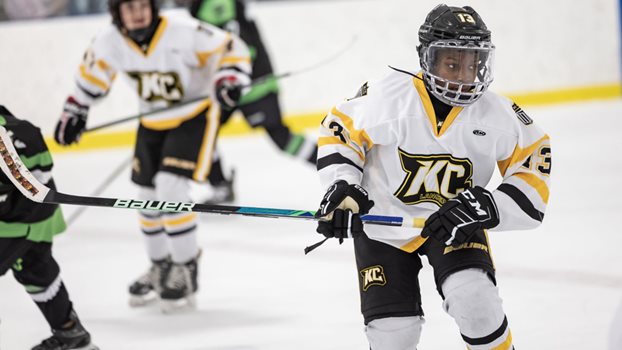
Assist Fund in Action: Brismoh Mansaray
With help from the Hockey Canada Foundation Assist Fund, the 12-year-old is flourishing in his first year of U13 AA hockey in Edmonton
When Brismoh Mansaray was five years old, he asked his dad a simple question.
“I was watching hockey with my dad when I asked him if I could play hockey, and he said sure,” recalls the Edmonton native, now 12.
Brismoh’s parents did what many do and first enrolled him — along with his sister — in skating lessons.
“We wanted him to just skate as a recreational activity,” recalls Brismoh’s mom, Iyesatu Jalloh. “But when he was skating, the coaches recommended registering him for hockey and told us how to do it.
Iyesatu says while she knew her son wanted to play hockey, she had her reservations and was hesitant to sign him up in a league.
“At one point, I tried to convince him to play soccer instead of hockey because it was too cold,” she says. “But then he cried the whole time he was at daycare, so the daycare teacher told me, ‘Please just let this boy play hockey.’”
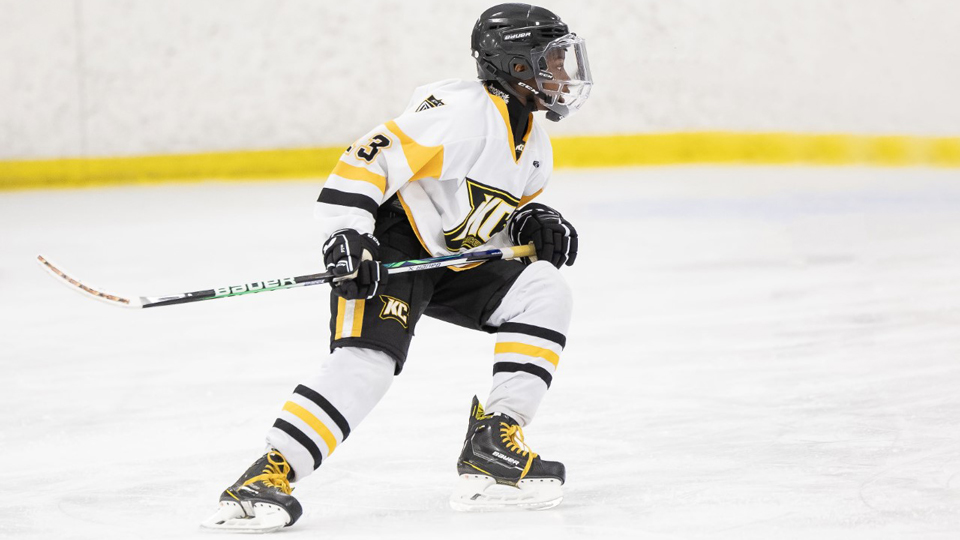
Brismoh's father suggested playing hockey might be beneficial for their son in more ways than one.
"His dad said, 'Let's just try it and maybe he will like it and maybe it will help him focus and he will not be on electronics all the time,' and I said OK," recalls Iyesatu.
So, in 2016, Brismoh was enrolled in Timbits U7 hockey. A year later, he joined the house league program with the KC Hockey Club, run by the Knights of Columbus Athletic Club in Edmonton, where he started out as a defenceman before becoming a forward.
“I was always rushing a lot,” says Brismoh, who is a big Edmonton Oilers fan and dreams of making it to the NHL someday.
Today, the right-winger is in his first full season of rep hockey as a member of the KC U13 AA Lancers.
“The best thing about playing hockey is that it is fun, and it gives me a hobby that I always want to do. I meet and make new friends every season,” Brismoh says.
Brismoh currently sits third on the team in scoring with 26 points and tied for third with 10 goals on the season. He is also excelling in school, much to the delight of his mother.
"He's doing good in hockey and he's doing good in school. His grades are in the 90s and he is doing good at home,” says Iyesatu.
With all the games, practices and high expectations that come with playing hockey, especially as a member of a rep team, Brismoh says it has all helped him stay focused not just on the ice, but off it too.
“Hockey has taught me how to focus on certain areas,” he says. “I don’t have a lot of time for anything else because of after hockey practice I have to study and then go to bed.”
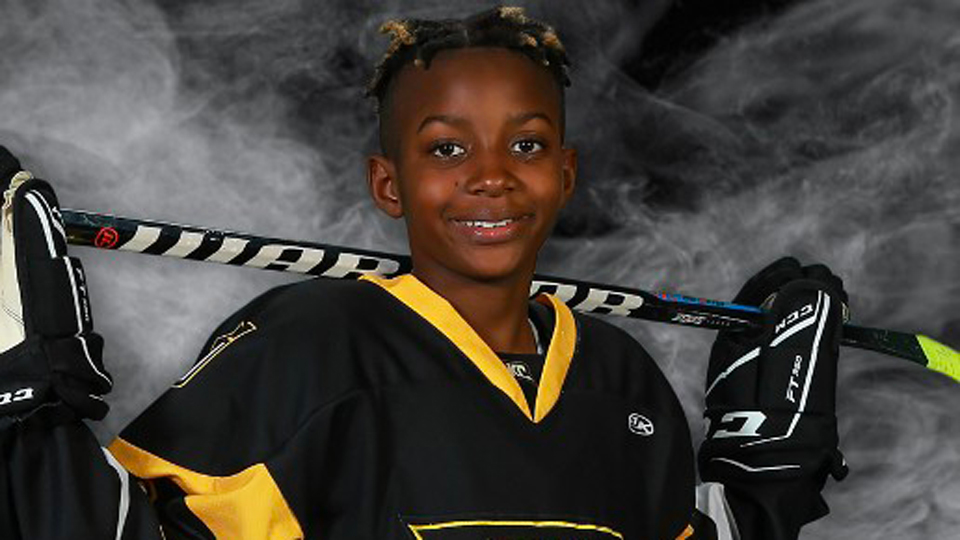
A helping hand
Brismoh was born in Edmonton, but his parents immigrated to Canada more than 20 years ago from Sierra Leone, where hockey, particularly the frozen kind, is virtually non-existent.
“We don’t do hockey back home,” says Iyesatu. “Sierra Leone, it’s mostly just soccer, track and field, basketball … because it’s like always 30 degrees and above.”
Though they had watched hockey before, they weren't completely familiar with everything that accompanies playing the game such as the equipment that is needed, or even how to put it on.
“We didn’t even know how to put the gear on him. We had to go on YouTube to see how to dress him up. It was really hard,” recalls Iyesatu, later adding. “The parents had to teach me how to tie his skates.”
To help Brismoh continue to make strides in the game, his family has turned to programs such as Hockey Canada Foundation Assist Fund, which provides $500 subsidies to help parents cover registration fees.
"The Assist Fund was really good for me because this year with AA, it was really expensive. I was really worried ... so when I got [help from] the Assist Fund, I was so happy," says Iyesatu.
Despite her initial hesitation towards her son playing hockey, Iyesatu says she is very proud of Brismoh’s success on and off the ice and is thrilled to see him playing the game he loves.
“I am so happy,” she says.
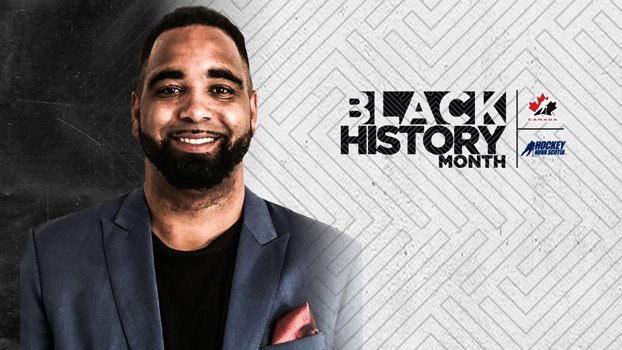
"If not now, then when?"
Inspired by hockey’s racial reckoning and last year’s social justice “awakening,” Rane Carnegie is carrying on his family’s legacy and working to get his trailblazing grandfather into the Hockey Hall of Fame
NOTE: This story was first published in February 2021. It has been updated with current information.
Rane Carnegie’s trailblazing grandfather is finally a member of the Hockey Hall of Fame.
Herb Carnegie, the founder of Canada’s first hockey school and an Order of Canada appointee, was posthumously inducted into the Hall last November as a builder, joining Roberto Luongo, Daniel Alfredsson, Henrik and Daniel Sedin, and Riikka Sallinen as part of the Class of 2023.
He joined Grant Fuhr, Willie O'Ree, Angela James and Jarome Iginla as the only Black members of the Hockey Hall of Fame.
Honoured to welcome Herb Carnegie, posthumously, to the Hockey Hall of Fame! Herb's children Bernice and Dale are presented with his Honoured Member plaque by Angela James #HHOF10.@CarnegieInit | #HHOF2022 | #HHOF | 📸 Dave Sandford/HHOF pic.twitter.com/BRQx7wrCFz
— Hockey Hall of Fame (@HockeyHallFame) November 15, 2022
“He deserved it,” says Rane. “My grandfather was a very special person, and everyone knew it.”
The induction comes after a renewed effort by the family to see Herb receive hockey’s highest honour. In 2020, Rane launched a petition, which garnered nearly 11,000 signatures, asking the Hockey Hall of Fame selection committee and the NHL to induct his grandfather, who passed away in 2012.
“The amount of people that came together to advocate and promote and share in this journey along way – because it wasn’t just this past year, it’s been a long time coming, and to see the joy and outpouring of love when it happened, it was truly amazing,” says Rane.
Read the original story on the career of Herb Carnegie and Rane’s efforts to have him recognized below.
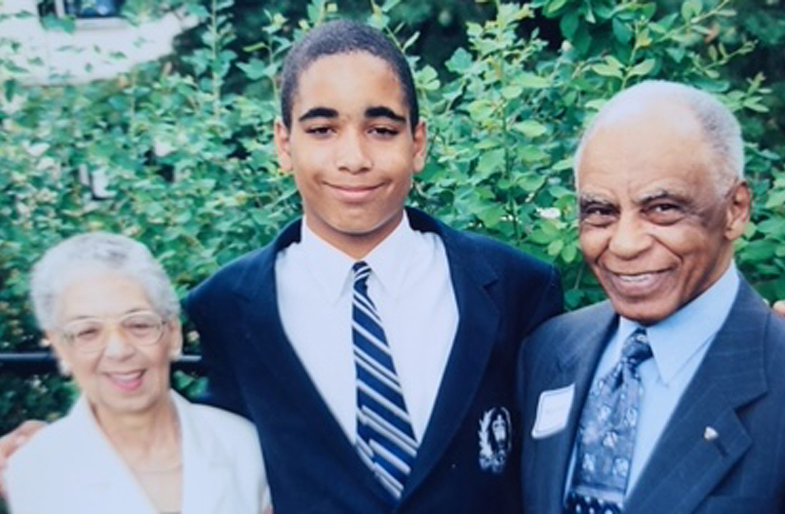
George Floyd.
Breonna Taylor.
Ahmaud Arbery.
Against the backdrop of a global pandemic, these names became rallying calls across North America during the summer of 2020 as the continent confronted centuries of systemic racism.
For Rane Carnegie, so much of the past year has been a call to action.
“It was traumatizing,” the 36-year-old former junior hockey star says.
“I have a Black son and a Black daughter. It impacted my family in a way that I can’t even begin to describe.”
The social justice movement that followed the deaths last year of Black men and women like Floyd, Taylor, and Arbery, took place in the wake of a racial reckoning throughout the game of hockey that was first sparked by Akim Aliu in the fall of 2019.
For Carnegie, the confluence of these movements was, what he calls, an awakening.
“It gave me the strength I needed to realize that I can be a leader and my actions matter,” Carnegie says. “My voice matters.”
“I wasn’t going to sit around and not do anything about it anymore.”
A PASSION FOR THE GAME
Carnegie’s passion for hockey comes honest enough.
His grandfather Herb Carnegie, widely considered to be the game’s first Black star, was a smooth-skating centre and a three-time winner of the Quebec senior league’s most valuable player award during the 1940s.
The son of Jamaican immigrants, he was also the man who showed up with a pair of skates at his grandson’s Toronto doorstep and first introduced him to the sport.
“I fell in love with the game from the moment I stepped foot on the ice with my grandfather.”
Like his grandfather who learned the game on the frozen ponds of north Toronto, it didn’t take long for the younger Carnegie to excel with those skates on.
An emerging hockey star in his own right, he caught the attention of junior hockey scouts early. In 2001, he was a first-round pick of the Ontario Hockey League’s Belleville Bulls.
His own hockey journey would bring him through the OHL and Quebec Major Junior Hockey League – where he starred with the Halifax Mooseheads – as well as the American Hockey League and other pro teams throughout the United States and Europe.
“As Canadians, you dream of playing for the Leafs and winning the Stanley Cup. It’s every kid’s dream and I was no different.
“[My dream] was just enhanced because of the legend of who my grandfather is and was.”
Despite his many accomplishments on the senior circuit in Quebec – the same league in which his former Quebec Aces teammate and lifelong friend Jean Béliveau cut his teeth – Herb Carnegie was never able to realize his own dream of playing in the National Hockey League.
That dream was snuffed out by institutional racism in the game. But despite all he endured, Herb Carnegie never stopped loving the sport or believing that hockey could be a vehicle for social change.
After hanging up his skates as a player in 1953, the elder Carnegie opened the Future Aces Hockey School, believed to be the first of its kind in the world.
He also penned the Future Aces Creed, a personal code that was part of his lifelong effort to promote respect and tolerance among young people, and to help ensure that future generations would not be subjected to the same kind of discrimination that he had experienced.
A hockey trailblazer and champion of diversity and inclusion, Herb Carnegie was named to the Order of Ontario in 1996, inducted into Canada’s Sports Hall of Fame in 2001 and invested into the Order of Canada in 2003.
He passed away in 2012 at the age of 92.
HIS ACTIONS MATTER, HIS VOICE MATTERS
For Rane Carnegie, there has always been one obvious accolade missing from his grandfather’s decorated resume: recognition from the Hockey Hall of Fame.
Last summer, following weeks of social unrest across the United States and Canada, and repeated calls from family and friends, the younger Carnegie was inspired to act.
So he launched a petition aimed at the Hockey Hall of Fame selection committee and the NHL with, what he thinks should be, a simple request: Include Dr. Herbert H. Carnegie in the Hockey Hall of Fame.
“I did it as a call to action for my Caucasian friends and family who were reaching out to me after the George Floyd incident,” Carnegie explains.
“They would come to me and say, ‘If we haven’t been an ally, we want you to know that we are.’”
If Herb Carnegie were to be inducted into the Hockey Hall of Fame, his grandson believes it would not only help right a racial wrong of the past, but it would be more than deserved for what he meant to the sport and what he accomplished on the ice.
Béliveau, who was inducted into the Hockey Hall of Fame 49 years ago, said that Herb Carnegie was one of the best players he ever played with.
“That tells me that my grandfather wasn’t just a hockey player,” Carnegie says. “When a superstar – an all-generational superstar like Jean Béliveau – is on record as saying that my grandfather was one of the best to have ever played with him, that to me tells me everything that I need to know, and it should for everyone else as well.”
Following the formation of the Hockey Diversity Alliance last summer, Carnegie points to his grandfather’s own humanitarian work with the Future Aces and believes there is no better time to recognize the contributions that his grandfather made to the sport as a player and a builder.
“[Diversity and inclusion] are what my grandfather was trying to teach for the last number of decades,” Carnegie says.
In the months since the petition was launched online, it has caught the attention of more than just Carnegie’s friends and family. In all, more than 7,000 people have expressed their support.
“We shouldn’t have to wait another year,” Carnegie says.
“If not now, then when? The time is now.”
CARRYING ON THE LEGACY
There are other ways Rane Carnegie is trying to preserve his grandfather’s legacy.
Last year, he established the O.W.N. Aces Sports Group, a mentorship and life-skills development initiative that has a similar objective to that of the Future Aces: to develop future leaders.
The former Mooseheads captain wants to share with young people some of the tough life lessons he has learned both on and off the ice. But his grandfather is never far from his work.
“He’s my guiding light,” Carnegie says.
“My grandfather was a ray of light. He still is. And I’m forever proud and humbled by my association to that great man.
“The game of hockey allowed us to have a special bond because he had the same love that I did.”
And like his grandfather, Rane Carnegie is giving back to that game. Today, he is a minor hockey coach with Toronto Young Nationals program in the Greater Toronto Hockey League.
“I love the game. I’m teaching in the game now. And my son plays hockey.
“It’s full circle. It’s all coming full circle.”
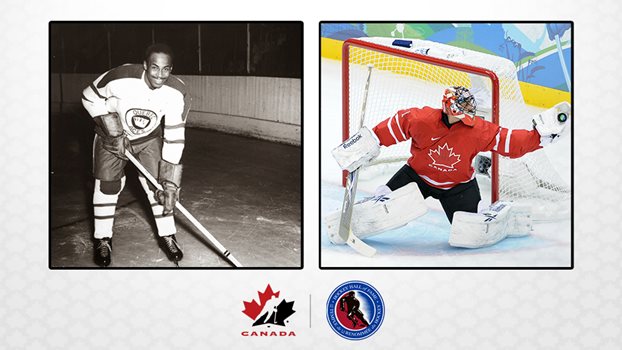
Dynamic duo headed to the Hall
Roberto Luongo and Herb Carnegie join four others in Class of 2022 for Hockey Hall of Fame
Two standout Canadians will be represented when the Class of 2022 goes into the Hockey Hall of Fame this fall.
Of the six names announced Monday, two have connections to Hockey Canada—legendary netminder Roberto Luongo will be enshrined in the player category, while Herb Carnegie will go in as a builder.
A closer look at the inductees…
Few goaltenders can match the international résumé of Roberto Luongo, who played 34 games across 10 events spanning 17 seasons, from the 1998 IIHF World Junior Championship to the 2014 Olympic Winter Games.
After earning Top Goaltender and Media All-Star Team honours at the 1999 World Juniors in Winnipeg, backstopping Canada to a silver medal, Luongo played in four IIHF World Championships in a five-year span from 2001-05, winning back-to-back gold medals in 2003 and 2004. Overall, only Sean Burke and Cam Ward have spent more time in the Canadian net at worlds than Luongo (856 minutes played).
In addition to his place on Canada’s championship-winning entry at the 2004 World Cup of Hockey, the Montreal product was also part of three Canadian contingents at the Olympic Winter Games, most notably at the 2010 Games in Vancouver when he capped his tournament with a 34-save effort in the gold medal game win over the U.S.
Honoured posthumously, Herb Carnegie is revered as one of the best players of his time and a pioneer for Black players in Canada. Carnegie battled racism and discrimination throughout his entire playing career, with many holding the view that he was kept out of the NHL simply because he was Black.
The Toronto-born forward was a standout in the Ontario and Quebec semi-professional leagues, earning three consecutive Quebec Senior Hockey League MVP awards from 1947-49. He joined the Quebec Aces in 1949-50 where he mentored another Canadian legend, Jean Béliveau—together winning the league championship in 1953. After retirement in 1954, he became a successful investor and founded one of Canada’s first hockey schools, the Future Aces, in 1955.
Carnegie’s family and friends had rallied together to get him into the Hockey Hall of Fame. They worked with the Hockey Diversity Alliance and created a petition to get him inducted in the Builder category to recognize his historic career that influenced generations of Black hockey players. Carnegie was also inducted into Canada’s Sports Hall of Fame in 2001 and the Ontario Sports Hall of Fame in 2014.
The duo will officially be inducted on Nov. 14 at the Hockey Hall of Fame in Toronto, joined by fellow inductees Daniel and Henrik Sedin, Daniel Alfredsson and Riikka Sallinen.
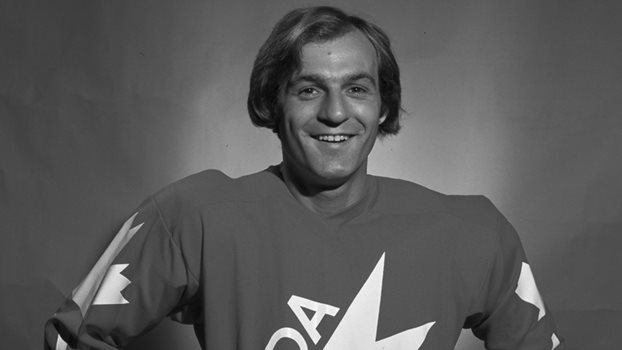
Guy Lafleur: 1951-2022
Hockey Canada sadly acknowledges the passing of the hockey legend, Team Canada alumnus and Order of Hockey in Canada honouree
It is with a heavy heart that Hockey Canada acknowledges the passing of Guy Lafleur.
One of the greatest French-Canadian stars in the history of the game, Lafleur, 70, was announced as a 2022 Distinguished Honouree of the Order ofHockey in Canada in January.
He will be posthumously invested into the Order during the Hockey Canada Foundation Gala in Niagara Falls, Ont., on June 23, alongside Lanny McDonald and Kim St-Pierre.
“Hockey Canada is deeply saddened to learn of the passing of hockey icon and 2022 Distinguished Honouree of the Order of Hockey in Canada, Guy Lafleur,” said Hockey Canada CEO Tom Renney, and president and COO Scott Smith. “On behalf of our entire organization, our deepest sympathies are with his wife Lise, his children Mark and Martin, his entire family, friends and all those who knew Guy and were privileged to play the game both alongside him and against him.
“Guy not only impacted the game, but changed how it was played. He was a hero to all those in Quebec, across the country and around the world. He was a true ambassador for the sport.”
The native of Thurso, Que., represented his country on three occasions – at the 1976 and 1981 Canada Cups, and at the 1981 IIHF World Championship. He recorded four goals and 14 assists in 21 Team Canada games, helping Canada to the 1976 Canada Cup title.
Lafleur is a Montreal Canadiens icon, spending 14 seasons in the bleu, blanc et rouge from 1971 to 1985, leading the Habs to five Stanley Cup championships (1973, 1976, 1977, 1978, 1979) and finishing his career as the franchise’s all-time leading scorer with 1,246 points (518-728—1,246) in 961 games. His No. 10 was retired by the Canadiens in 1985.
Honoured as one of the 100 Greatest NHL Players, he was a two-time Hart Trophy recipient as NHL MVP (1976-77, 1977-78), a three-time Art Ross Trophy winner (1975-76, 1976-77, 1977-78) and a six-time First Team All-Star (1974-75, 1975-76, 1976-77, 1977-78, 1978-79, 1979-80), among countless other awards.
Lafleur’s impact transcended hockey; he earned the Lou Marsh Trophy as Canada’s top athlete in 1977, the year he set a career high with 136 points before adding another 26 in the playoffs, taking home his only Conn Smythe Trophy as playoff MVP.
His offensive exploits in junior hockey were even more outrageous than his NHL accomplishments; in his final two QMJHL seasons with the Quebec Remparts, Lafleur posted a remarkable 233 goals and 379 points, including a 130-goal season in 1970-71, when he captained the Remparts to the Memorial Cup title.
He was inducted into the Hockey Hall of Fame in 1988, the same year he ended his three-year retirement and returned to the NHL with the New York Rangers. He spent one season on Broadway and two more with the Quebec Nordiques before calling it a career for the final time in 1991.
Lafleur was a 1996 inductee into Canada’s Sports Hall of Fame and a 1993 inductee into the Pantheon des sports du Québec, was invested as an Officer of the Order of 1980 and was made a Knight of the National Order of Quebec in 2005.

Celebrating future hockey leaders
Meet the three young Canadians who recently received Black Girl Hockey Club scholarships as they continue to grow and become leaders in Canada’s game
With the goal to inspire and sustain passion for hockey in the Black community, the Black Girl Hockey Club (BGHC) works to provide education and community spaces to make hockey more inclusive for Black women and their family, friends and allies. To further assist and encourage Black women to pursue their interest in hockey, BGHC has a scholarship program to help subsidize the costs of the sport.
Andrea Murray, Hailey James and Dayton O’Donoghue were honoured with BGHC scholarships at the beginning of February. Get to know these bright young players who are developing into leaders on their teams and in the game.
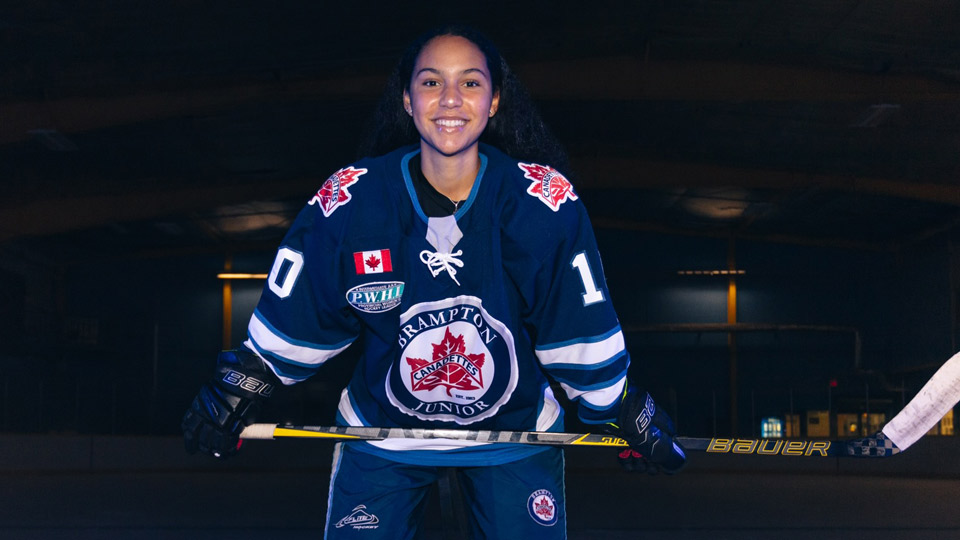 Andrea Murray
Hometown: Mississauga, Ont.
Andrea Murray
Hometown: Mississauga, Ont.
Growing up in a sports-oriented family, Murray played ringette with her sister before she decided to try playing a different sport. Her brother and father played hockey, so she followed in their footsteps and gave it a try.
“I wasn’t the greatest at it; I had to take time to get better,” the 18-year-old says. “I did skate, but I could not stick-handle or shoot, so it took some time to get good. Ever since then, I’ve been playing it and I’ve fallen in love with the game.”
One of Murray’s favourite things about playing hockey is the ability to build strong relationships with other young women.
“Hockey isn’t just a sport. You create a family dynamic, both on and off the ice,” says Murray, who plays for the Brampton Canadettes. “The bonds and friendships and the different families you get to meet at the rink is the key and the highlight of the game.”
Through BGHC, Murray has been able to expand her hockey community, particularly by meeting Black players that love the game as much as she does.
“Growing up, I didn’t really have any other Black teammates and when I did see a Black player at the rink, I almost felt some sort of comfort, as it was so nice and reassuring to see other people playing hockey who look just like me,” she says. “The Black Girl Hockey Club has allowed and exposed [me to] so many other Black hockey players from all over North America, and it’s so exciting to see where they go and where they end up.”
This fall, Murray is looking forward to continuing her hockey journey as a member of the women’s hockey team at the University of Waterloo. She also has her eyes on making Canada’s National Women’s Team and potentially representing her country at the Olympics.
“That takes a lot of hard work and dedication, and I’m willing to put all
that work in and get exposed to different teams.”

Hailey James Hometown: Brampton, Ont.
Hockey is a big part of James’ family with her father and brothers playing the game, so she was quick to get on the ice starting at four years old.
“I wanted to try it out and see if I liked it,” says James, 11.
Turns out, she loved it. Her father, Leo, began coaching her minor hockey teams as she started her hockey journey.
For James, one of the best parts about hockey is being able to play with her friends and continuously looking for opportunities to improve her game every time she hits the ice. Her motivation to always do better has translated into great leadership skills with her team, the Scarborough Sharks.
“If they are not playing their position or if they have a rough time playing their position, I usually help them out with it,” she says. “If they need help with something, I help them out… if they think they did something wrong, I make sure that they’re OK and tell them that they didn’t do anything wrong.”
When James found out that she had been awarded a BGHC scholarship, she was delighted.
“I felt excited,” she says. “I told my friends and my favourite teacher and they’re all proud of me.”
Although there are hockey connections in her immediate family, the young left-winger is also inspired by her aunt—Angela James, the first Canadian woman to earn induction into the Hockey Hall of Fame—as she paves her own path in the game. James hopes to follow in her aunt’s footsteps when she’s older by playing at a professional level and representing Team Canada.
“I have an ultimate goal and it’s to follow my aunt and try to be as
[great] as her,” James says. “She [gives me advice] all the time… to just
try your best and work hard. And if you mess up, just try again until you
get it right.”
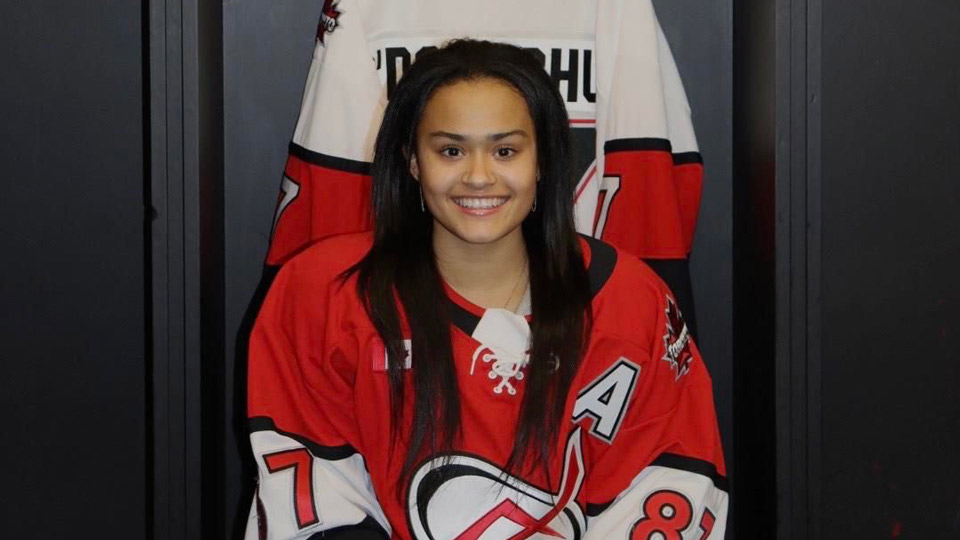
Dayton O’Donoghue Hometown: Toronto, Ont.
O’Donoghue was introduced to the sport through her mother after she signed up her older brother for hockey.
“My mom moved to Canada when she was eight years old from Jamaica and hockey was a huge part of Canadian culture,” she says. “I would just tag along as the second child to the rink, but I loved it. I was so captivated by the speed. [My brother] wasn’t able to make one of his ice times, so I jumped on instead.”
Since her first time on the ice, O’Donoghue has fallen in love with the game. Her hockey career has brought many exciting opportunities for the 16-year-old, including becoming a member of the NHL Youth Advisory Board and being a judge for the Breakaway Challenge at this year’s NHL All-Star Skills Competition.
The Toronto Jr. Aeros centre was also recently featured in Bauer’s “The Barn” campaign, where she got to share her hockey journey.
“Being able to be recognized by [Bauer] and then having them share my story on their platform, it was really validation for me that, you know what, I belong in the sport and even if there aren’t a lot of girls that play and there aren’t a lot of Black girls that play, I belong here. I’m loved in this community ,” she says.
The power of the hockey community particularly impacted O’Donoghue when her father passed away early in her hockey career. She found comfort in the support of her teammates and her love of the game.
“No matter how I walk into the arena, upset or really feeling down about my dad one day, I can always walk in and know that if I’m not feeling my best today, I have my teammates to lean on. It’s OK not to be OK.”
This is the second scholarship O’Donoghue has received from BGHC. Not only has the financial support greatly impacted her, but she was also connected into the Saroya Strong mentorship program and receives guidance and leadership from Saroya Tinker, a Team Canada alumna and Premier Hockey Federation standout.
As for the future, O’Donoghue dreams of wearing the Maple Leaf one day and has a goal to play college hockey while completing her post-secondary studies. She is also encouraged by opportunities for hockey to continue to increase its inclusivity and diversity.
“I’m really hopeful that we can continue to get more perspective into our game,” she says. “I feel that is what can make our sport even better, having different opinions and different minds and different people helping to shape our game and continuously evolve it.”
For more information: |
- <
- >
















